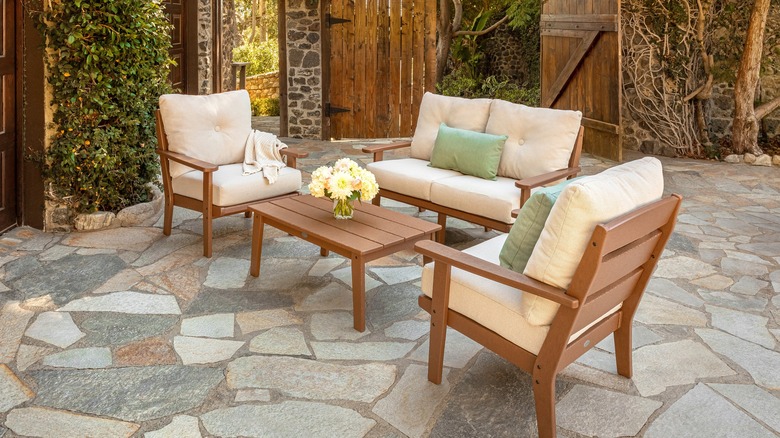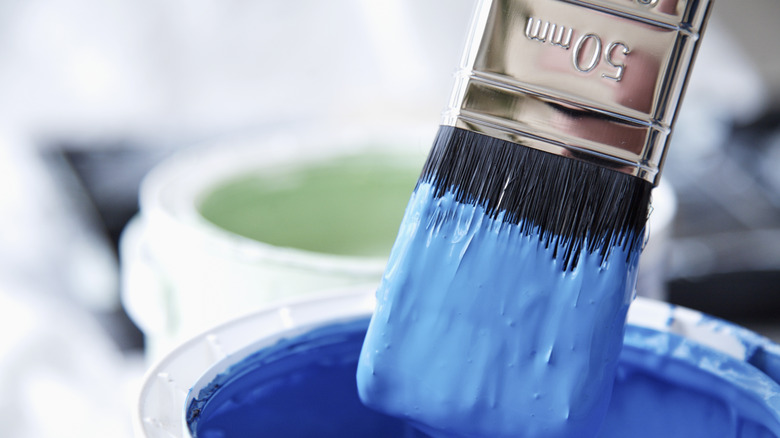What Polywood Furniture Is Actually Made Of (& Is It The Right Choice For Your Home?)
Browsing patio furniture for your home often involves looking at an array of brands, styles, and materials. One option, polywood furniture, may come up in your searches, maybe leading you to wonder what polywood is. Despite its name, polywood isn't real wood but has a wood-like appearance. It's crafted from recycled High-density polyethylene (HDPE) plastic, which is the same plastic used in items like shampoo bottles, milk jugs, and flower pots. The poly part of its name comes from polyethylene, while wood refers to the way manufacturers make it resemble wood grain. When deciding if polywood furniture is right for your home, you need to factor in cost, weight, heat conditions, and aesthetics.
POLYWOOD (all capitals) is the brand name of the first company to manufacture polywood furniture after CEO Doug Rossi pioneered the technique. Today, other companies, in addition to POLYWOOD, produce similar products. Regardless of the brand, these outdoor furnishings have grown in popularity for their durability, weather-resistance, and sustainable nature. Because they look like wood but feature recycled materials, they're an eco-friendly way to decorate your home. Whether shopping at Costco for a complete patio makeover or just wanting to add a single new chair for comfort, there's a wide range of polywood pieces available in all shades and styles. However, before you rush out and buy a complete set of polywood pieces for your deck or patio, here's what you need to know to make an informed decision.
Is polywood right for your home?
Polywood is typically more expensive upfront than wood or other materials you might choose for patio furniture, so it's not suitable for budget-conscious buyers. However, if you're looking for a long-lasting, high-quality piece, polywood can be perfect. The exact furniture lifespan varies by manufacturer, with an average 15-year lifetime. It might be a worthy investment, considering that polywood requires less maintenance than wood. There's no need to stain it, nor will it rot or decay, even in extreme weather. If you've ever picked up a handful of splinters from sitting on old wooden patio furniture, you can see the value in this!
As it can be quite heavy, polywood may be unsuitable on older decks or balconies. Relocation is challenging, so if you have problems moving heavy objects, you might pass on polywood. On the other hand, the weight is advantageous in wind, helping it stay put. Another concern is heat. Polywood can heat up faster than wood. Moving your furniture out of direct sunlight and using shade umbrellas or awnings can help keep it cooler, as can seating cushions. But if you live in a consistently hot area, you might reconsider your purchase.
Aesthetics can be tricky with polywood furniture
There's a diverse selection of polywood furniture colors so you can easily find an option that complements your home, creating the patio or deck of your dreams. Plus, because of its manufacturing process, the items will endure, with the color resisting chipping or scratching. This endurance can be an obstacle if you decide you want a new look. After investing so much in your furniture, it's understandable if you want to refresh it with a new look after a few years. It's relatively easy to refresh wood patio furniture, as well as pieces made of metal, but it might be a more cumbersome process with polywood.
The color is present throughout all of the polywood's fibers, meaning it's there to stay unless you give it a new coat of paint. You'll need to sand it then use a primer for plastics to prepare it for painting. Sanding can remove any protective finish, potentially reducing durability. Depending on the brand, sanding or painting your furniture may void your warranty, so always read the fine print before buying and especially modifying polywood.


